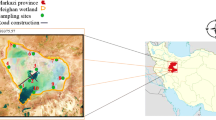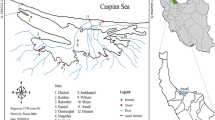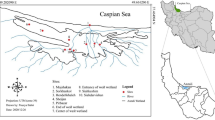Abstract
Eichhornia crassipes is one of the most ubiquitous invasive aquatic species in the world that negatively impact on native fauna and flora. The information on the occurrence of such invasive plant is crucial for the river/wetland management. The aim of the present study is to apply classification tree model (testing with the highest level of pruning confidence factor) integrated with an optimizer technique (greedy stepwise search algorithm) to predict the occurrence of this exotic species based on water quality and physical-habitat parameters. The ten sites (in the Anzali wetland, located in northern Iran) were monthly measured where the exotic species was present in 50 % of sampling sites and it was absent in the remaining of the sites. In total, 120 samples of E. crassipes (60 presence and 60 absence instances) were monthly measured together with 12 environmental variables during 1-year study period (2017–2018). For the model, two-third of datasets (80 instances) was employed for the training and the remainder for the validation set (40 instances). Before model optimizing (with the pruning confidence factor, PCF = 0.01), six variables were predicted by the model in three folds confirming that the non-occurrence of the exotic species might be associated with increasing flow velocity, depth of ecosystem, water turbidity, bicarbonate and dissolved oxygen concentration, while the occurrence of the exotic species (in terms of the abundance) might show an increase with increasing the concentration of nutrients such as phosphate. After model optimizing (with PCF = 0.01), the model selected five variables in three folds (flow velocity, depth, phosphate, bicarbonate, and nitrate) so that except nitrate, other selected variables were in common before and after variable selection. CT integrated with GS model thus proved to have a high potential when applied for decision-making in the context of wetland management.




Similar content being viewed by others
Data Availability
If article and information are requested the corresponding author will be available to respond the request. Code availability. WEKA software is a free software which was used in the present study.
References
Albright TP, Moorhouse T, McNabb T (2004) The rise and fall of water hyacinth in Lake Victoria and the Kagera River Basin, 1989–2001. Journal of Aquatic Plant Management 42:73–84
Ambelu A, Lock K, Goethals PLM (2010) Comparison of modelling techniques to predict macroinvertebrate community composition in rivers of Ethiopia. Ecological Informatics 5:147–152
APHA/AWWA/WEF (1998) Standard methods for the examination of water and wastewater, 19th ed. Washington, DC, USA
Blum A, Langley P (1997) Selection of relevant features and examples in machine learning. Artificial Intelligence 97:245–271
Buckland ST, Elston DA (1993) Empirical-models for the spatial-distribution of wildlife. Journal of Applied Ecology 30:478–495
Butterworth R, Simovici DA, Santos GS, Ohno-Machado L (2004) A greedy algorithm for supervised discretization. Journal of Biomedical Informatics 37:285–292
Clout MN, Williams PA (2009) Invasive species management: A handbook of principles and techniques. Oxford University Press, Oxford, 331 pp
Cohen J (1960) A coefficient of agreement for nominal scales. Educational and Psychological Measurement 20:37–46
Dakou E, D’heygere T, Dedecker AP, Goethals P, Lazaridou-Dimitriadou M, De Pauw N (2007) Decision tree models for prediction of macroinvertebrate taxa in the river Axios (Northern Greece). Aquatic Ecology 41:399–411
Darvish Bastami K, Neyestani MR, Molamohyedin N, Shafeian E, Haghparast S, Shirzadi IM, Baniamam M (2018) Bioavailability, mobility, and origination of metals in sediments from Anzali Wetland, Caspian Sea. Marine Pollution Bulletin 136:22–32
De’ath G, Fabricius KE (2000) Classification and regression trees: a powerful yet simple technique for ecological data analysis. Ecology 81:3178–3192
Dom B, Niblack W, Sheinvald J (1989) Feature selection with stochastic complexity. In: Proceedings of IEEE on Computer Vision and Pattern Recognition, Rosemont 241–248
Dominguez-Granda L, Lock K, Goethals PLM (2011) Application of classification trees to determine biological and chemical indicators for river assessment: case study in the Chaguana watershed (Ecuador). Journal of Hydroinformatics 13:489
Epstein P (1998) Weeds bring disease to the east African waterways. Lancet 351:577
Everaert G, Boets P, Lock K, Džeroski S, Goethals PLM (2011) Using classification trees to analyze the ecological impact of invasive species in polder lakes in Flanders, Belgium. Ecological Modelling 222:2202–2212
Faraway J, Chatfield C (1998) Time series forecasting with neural network: a comparative study using airline data. Journal of Applied Statistics 47:231–250
Fernández-Zamudio R, García-Murilloa P, Cirujano S (2010) Germination characteristics and sporeling success of A. filiculoides Lam., an aquatic invasive fern, in a Mediterranean temporary wetland. Aquatic Botany 93:89–92
Fielding AH, Bell JF (1997) A review of methods for the assessment of prediction errors in conservation presence/absence models. Environmental Conservation 24(01):38–49
Gevrey M, Dimopoulos L, Lek S (2003) Review and comparison of methods to study the contribution of variables in artificial neural network models. Ecological Modelling 160:249–264
Güereña D, Neufeldt H, Berazneva J, Dubyd S (2015) Water hyacinth control in Lake Victoria: Transforming an ecological catastrophe into economic, social, and environmental benefits. Sustainable Production Consumption 3:59–69
Haghi Vayghan A, Zarkami R, Sadeghi R, Fazli H (2015) Modelling habitat preferences of Caspian kutum, Rutilus frisii kutum (Kamensky, 1901) (Actinopterygii, Cypriniformes) in the Caspian Sea. Hydrobiologia 766:103–119
Hall MA, Holmes G (2003) Benchmarking attribute selection techniques for discrete class data mining. IEEE Transactions on Knowledge Data Engineering 15:1437–1447
Heard TA, Winterton SL (2000) Interactions between nutrient status and weevil in the biological control of water hyacinth. Journal of Applied Ecology 37:117–127
Jeppesen E, Jensen J, Sandergaard M, Lauridsen T, Pedersen L, Jensen L (1997) Top-down control in freshwater lakes: the role of nutrient state, submerged macrophytes and water depth. Hydrobiologia 342:151–164
JICA (Japan International Cooperation Agency) (2005) The study on integrated management of the Anzali Wetland in the Islamic republic of Iran-final report, 222 pp
Kohavi R (1995) A study of cross-validation and bootstrap for accuracy estimation and model selection. In: Lavrac M, Wrobel S (eds.). Proceedings of the International Joint Conference on Artificial Intelligence, 1137–1143
Lock K, Goethals P (2012) Habitat suitability modelling for mayflies (Ephemeroptera) in Flanders (Belgium). Ecological Informatic 17:30–35
Lowe S, Browne M, Boudjelas S, De Poorter M (2000) 100 of the world’s worst invasive alien species. A selection from the global invasive species database. The Invasive Species Specialist Group (ISSG) a specialist group of the Species Survival Commission (SSC) of the World Conservation Union (IUCN)
Malik A (2007) Environmental challenge vis a vis opportunity: the case of water hyacinth. Environment International 33:122–138
Manel S, Williams HC, Ormerod SJ (2001) Evaluating presence–absence models in ecology: the need to account for prevalence. Journal of Applied Ecology 38:921–931
Muramoto S, Aoyama I, Oki Y (1991) Effect of salinity on the concentration of some elements in water hyacinth (Eichhornia crassipes) at critical levels. Journal of Environmental Science Health 26:205–215
MWBP/RSCP (2006) Invasive alien species in the lower mekong basin: Current state of play. Mekong Wetland Biodiversity Programme and Regional Species Conservation Programme, The World Conservation Union (IUCN), Asia, Sri Lanka, 22 pp
Nguyen T, Boets P, Lock K, Ambarita M (2015) Habitat suitability of the invasive water hyacinth and its relation to water quality and macroinvertebrate diversity in a tropical reservoir. Limnologica 52:67–74
Olivares E, Colonnello G (2000) Salinity gradient in the Mánamo River, a dammed distributary of the Orinoco Delta, and its influence on the presence of Eichhornia crassipes and Paspalum repens. Interciencia 25:242–248
Opande GO, Onyango JC, Wagai SO (2004) Lake Victoria: The water hyacinth (Eichhornia crassipes [Mart.] Solms), its socio-economic effects, control measures and resurgence in the Winam gulf. Limnologica 34:105–109
Pimentel D (2005) Environmental and economic costs of the application of pesticides primarily in the United States. Environment, Development and Sustainability 7:229–252
Pushpa GS, Volin JC (2010) Does water hyacinth (Eichhornia crassipes) compensate for simulated defoliation? Implications for effective biocontrol. Biological Control 54:35–40
Quinlan JR (1986) Induction of decision trees. Machine Learning 1:81–106
Quinlan JR (1993) C4.5, Program for Machine Learning. Morgan Kaufmann Publishers, San Francisco, p 302
Rodriguez LF (2006) Can invasive species facilitate native species? Evidence of how, when, and why these impacts occur. Biological Invasions 8:927–939
Sadeghi R, Zarkami R, Sabetraftar K, Van Damme P (2012) Use of support vector machines (SVMs) to predict distribution of an invasive water fern Azolla filiculoides (Lam.) in Anzali wetland, southern Caspian Sea, Iran. Ecological Modelling 244:117–126
Sadeghi R, Zarkami R, Sabetraftar K, Van Damme P (2012) Application of classification trees to model the distribution pattern of a new exotic species Azolla filiculoides (Lam.) in Selkeh Wildlife Refuge, Anzali wetland, Iran. Ecological Modelling 243:8–17
Sadeghi R, Zarkami R, Sabetraftar K, Van Damme P (2013) Application of genetic algorithm and greedy stepwise to select input variables in classification tree models for the prediction of habitat requirements of Azolla filiculoides (Lam.) in Anzali wetland, Iran. Ecological Modelling 251:44–53
Sadeghi R, Zarkami R, Sabetraftar K, Van Damme P (2013) A review of some ecological factors affecting the growth of Azolla spp. Caspian Journal of Environmental Science 11:65–76
Sadeghi R, Zarkami R, Van Damme P (2017) Analyzing the occurrence of an invasive aquatic fern in wetland using data-driven and multivariate techniques. Wetlands Ecology and Management 25(4):485–500
Schultz R, Dibble E (2012) Effects of invasive macrophytes on freshwater fish and macroinvertebrate communities: the role of invasive plant traits. Hydrobiologia 684:1–14
Sharma A, Gupta MK, Singhal PK (1996) Toxic effects of leachate of water hyacinth decay on growth of Scenedesmus obliquus (Chlorophyta). Water Resources 30:2281–2286
Shu X, Deng Q, Zhang Q, Wang W (2015) Comparative responses of two water hyacinth (Eichhornia crassipes) cultivars to different planting densities. Aquatic Botany 121:1–8
Stiers I, Crohain N, Josens G, Triest L (2011) Impact of three aquatic invasive species on native plants and macroinvertebrates in temperate ponds. Biological Invasions 13:2715–2726
Sun WH, Yu SW, Yang SY, Zhao PW, Yu ZW, Wu HM et al (1993) Allelochemicals from root exudates of water hyacinth. Acta Phytophysiol Sinica 19:92–96
Téllez TR, López EM, Granado G, Pérez EA, López RM, Sanchez Guzmán JM (2008) The Water Hyacinth, Eichhornia crassipes: an invasive plant in the Guadiana River Basin (Spain). Aquatic Invasions 3:42–53
Theel HJ, Dibble ED, Madsen JD (2008) Differential influence of a monotypic and diverse native aquatic plant bed on a macroinvertebrate assemblage; an experimental implication of exotic plant induced habitat. Hydrobiologia 600(1):77–87
Thuiller W, Lafourcade B, Engler R, Araújo M (2009) BIOMOD - a platform for ensemble forecasting of species distributions. Ecography 32:369–373
UNEP, Global Environmental Alert Service (GEAS) (2013) Water hyacinth- Can its aggressive invasion be controlled? Environment and Development 7:139–154
Villamagna AM, Murphy BR (2010) Ecological and socio-economic impacts of invasive water hyacinth (Eichhornia crassipes): a review. Freshwater Biology 55:282–298
Wilson JR, Holst N, Rees M (2005) Determinants and patterns of population growth in water hyacinth. Aquatic Botany 81:51–67
Witten IH, Frank E, Hall MA (2011) Data mining, practical machine learning tools and techniques, 3rd edn. Morgan Kaufmann, San Francisco, 629 pp
Zarkami R (2016) Invasive aquatic plants. Haghshanas Publishing Press. 184 pp (in Farsi)
Zarkami R, Sadeghi R, Goethals P (2014) Modelling occurrence of roach “Rutilus rutilus” in streams. Aquatic Ecology 48:161–177
Zarkami R, Moradi M, Sadeghi R, Bani A, Abbasi K (2018) Input variable selection with greedy stepwise search algorithm for analyzing the probability of fish occurrence: A case study for Alburnoides mossulensis in the Gamasiab River, Iran. Ecological Engineering 118:104–110
Zarkami R, Darizin Z, Sadeghi R, Bani A, Ghane A (2019) Use of data-driven model to analyse the occurrence patterns of an indicator fish species in river: A case study for Alburnoides eichwaldii (De Filippi, 1863) in Shafaroud River, north of Iran. Ecological Engineering 133:10–19
Zarkami R, Hesami H, Sadeghi Pasvisheh R (2020a) Assessment, monitoring and modelling of the abundance of Dunaliella salina Teod in the Meighan wetland, Iran using decision tree model. Environmental Monitoring and Assessment 192:172. https://doi.org/10.1007/s10661-020-8148-y
Zarkami R, Kia S, Sadeghi Pasvisheh R (2020b) Modelling the habitat preferences of the swan mussel (Anodonta cygnea) using data-driven model. Environmental Monitoring and Assessment 192:685. https://doi.org/10.1007/s10661-020-08651-1
Zarkami R, Hesami H, Sadeghi Pasvisheh R (2020c) Prediction of the abundance of Artemia parthenogenetica in a hypersaline wetland using decision tree model. Wetlands. https://doi.org/10.1007/s13157-020-01332-2
Acknowledgements
The authors would like to acknowledge Pourya Bahri for providing the map of the sampling sites. He is following his Master of Science study in the Department of Environmental Science, Faculty of Natural Resources, University of Guilan, Iran.
Author information
Authors and Affiliations
Contributions
RZ: sampling design, data collection and manuscript writing; JE: data collection; RS: sampling design, the proposed modelling techniques and manuscript writing.
Corresponding author
Ethics declarations
Conflicts of Interest/Competing Interests
The authors declare no conflicts of interest/competing interest.
Ethics Approval
Approved by the faculty of natural resources, University of Guilan.
Consent to Participate
All authors declared the consent to participate.
Consent for Publication
All authors declared the consent for publication.
Additional information
Publisher’s Note
Springer Nature remains neutral with regard to jurisdictional claims in published maps and institutional affiliations.
Rights and permissions
About this article
Cite this article
Zarkami, R., Esfandi, J. & Sadeghi, R. Modelling Occurrence of Invasive Water Hyacinth (Eichhornia crassipes) in Wetlands. Wetlands 41, 8 (2021). https://doi.org/10.1007/s13157-021-01405-w
Received:
Revised:
Accepted:
Published:
DOI: https://doi.org/10.1007/s13157-021-01405-w




